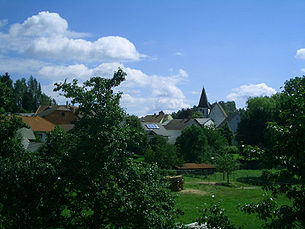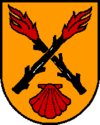Schönau in the Mühlkreis
|
Schönau in the Mühlkreis
|
||
|---|---|---|
| coat of arms | Austria map | |
|
|
||
| Basic data | ||
| Country: | Austria | |
| State : | Upper Austria | |
| Political District : | Free City | |
| License plate : | FR | |
| Surface: | 38.54 km² | |
| Coordinates : | 48 ° 24 ' N , 14 ° 44' E | |
| Height : | 635 m above sea level A. | |
| Residents : | 1,958 (January 1, 2020) | |
| Postal code : | 4274 | |
| Area code : | 07261 | |
| Community code : | 4 06 19 | |
| NUTS region | AT313 | |
| Address of the municipal administration: |
Schönau 2 4274 Schönau im Mühlkreis |
|
| Website: | ||
| politics | ||
| Mayor : | Herbert Haunschmied ( ÖVP ) | |
|
Municipal Council : (2015) (19 members) |
||
| Location of Schönau im Mühlkreis in the Freistadt district | ||
 View of the town of Schönau |
||
| Source: Municipal data from Statistics Austria | ||
Schönau im Mühlkreis is a municipality in Upper Austria in the Freistadt district in the Mühlviertel with 1958 inhabitants (as of January 1, 2020). The municipality is located in the judicial district of Perg .
geography
Schönau im Mühlkreis lies at an altitude of 635 m in the Mühlviertel. The extension is 9.7 km from north to south and 8.5 km from west to east. The total area is 38.6 km². 17.4% of the area is forested and 19.7% of the area is used for agriculture. Schönau is a large community bordered by the Waldaist in the north and the Kleine Naarn in the south .
Community structure
The municipality includes the following 17 localities (population in brackets as of January 1, 2020):
- Almblick (24)
- On the mountain (79)
- Baby (81)
- Hofing (70)
- Kaining (90)
- Kollnedt (6)
- Niederndorf (131) including Hahneder
- Oberndorf (173) including Bauxlehner and Edlau
- Oberwolfgrub (24)
- Pehersdorf (60)
- Prandegg (60)
- Schönau im Mühlkreis (880)
- Sonnblick (55)
- Steinbichl (26)
- Strass (77)
- Unteriederndorf (22)
- Wolfgrub (100)
The community consists of the cadastral communities Kaining, Prandegg and Schönau im Mühlkreis.
Schönau is a member of the Association for Regional and Tourism Development Mühlviertler Alm .
Neighboring communities
| St. Leonhard | Kaltenberg | |
| Gutau |

|
Unterweißbach |
| Bad Zell | Pierbach |
history
Schönau is a founding of the Lords of Machland , first documented around 1230. The parish church is first mentioned around 1230 and dedicated to St. Consecrated to James . At the time of the medieval long-distance pilgrimages, a pilgrimage from Poland to Santiago de Compostela in Spain led through the town.
The Thirty Years War and the Turkish siege of Vienna spared Schönau. In 1536 the Protestant Hilleprant bought Jörger the castle Prandegg of the of Regensburg. Jörger made Schönau a base for the new religion. With the Counter-Reformation , the majority of the Schönau population became Catholic again. From the period 1660 to 1730 superstition took hold and a case of a witch trial has come down to us. Until 1848, the municipality was subordinate to other lords, mainly the lords of Prandegg , Zellhof Castle , Schwertberg and Ruttenstein .
The administration change followed in 1848 and Schönau became a municipality. Since 1918 the place belongs to the federal state of Upper Austria. In 1920 the community issued emergency money to alleviate the economic burden.
After Austria was annexed to the German Reich on March 13, 1938, the place belonged to the "Gau Oberdonau". After 1945 Schönau was in the Soviet occupation zone and after 1955 the infrastructure was expanded and rebuilt. Until the end of 2002, the community belonged to the judicial district Unter Weißenbach , from 2003 to 2013 to the judicial district Pregarten , and on January 1, 2013 it was assigned to the judicial district Perg .
Population development
| Population development | ||||
|---|---|---|---|---|
| year | Residents | year | Residents | |
| 1869 | 1,667 | 1951 | 1,589 | |
| 1880 | 1,700 | 1961 | 1,629 | |
| 1890 | 1,683 | 1971 | 1,708 | |
| 1900 | 1,703 | 1981 | 1,736 | |
| 1910 | 1,700 | 1991 | 1,823 | |
| 1923 | 1,770 | 2001 | 1,818 | |
| 1934 | 1,800 | 2008 | 1,885 | |
| 1939 | 1,677 | |||
In 1869 there were 1667 people living in the municipality. Until 1971, the population fluctuated around this value and hardly grew. In 1991 the municipality had 1,823 inhabitants, in the 2001 census only 1,818, which corresponds to a decrease of 0.3%. On January 1st, 2008 the community had 1,885 inhabitants, the highest level in history and there is an increase in population. The population continues to develop positively due to the development of new building sites. As the traffic routes are getting better and better, Schönau is moving closer to Linz: the city entrance in the north can be reached in half an hour by car.
In the 2001 census, the proportion of residents who were 60 years of age and older was 18.3%; 20.6% were under 15 years old. The proportion of the female population was 49.8%.
Of the 1443 residents of Schönau, who were over 15 years old in 2001, 1.9% had graduated from a university , technical college or academy . Another 5.4% had completed a high school diploma, 46% had completed an apprenticeship or a vocational middle school and 46.6% of all Schönauers had compulsory school as their highest qualification.
Origin and language
The German dialect that is commonly spoken in the Schönau area and in Upper Austria is Middle Bavarian . In 2001, 99.7% of those in Schönau cited German as their everyday language. Another 0.1% spoke mainly Czech , the rest spoke other languages.
The proportion of Schönau residents with foreign citizenship was 0.9% in 2001, well below the average in Upper Austria. 0.1% of the Schönau population had citizenship from Bosnia-Herzegovina , 0.4% from Germany and 0.4% were other citizens. In 2001, around 0.8% of Schönau residents were born in a country other than Austria.
Partnerships
The municipality has a partnership with the Polish municipality of Gizalki . Gizalki is part of the Plescew district , which in turn is a partner district of the Ammerland district .
coat of arms
Description of the municipal coat of arms : there are two black, diagonally crossed fires in gold , including a red shell. The fires are a coat of arms of the Pranter ministerial family, who built the first Prandegg Castle at the beginning of the 13th century . The red shell stands for St. James the Elder , the church patron, and symbolizes a pilgrim shell. The community colors are red and yellow.
The municipal coat of arms and colors were awarded on April 24, 1972.
politics
The municipal council and mayoral elections take place every six years, at the same time as the state elections. From 1945 until 1997 the ÖVP always achieved an absolute majority. The second strongest party was the SPÖ . The FPÖ was always the third strongest party, but only competed in 1991 and 1997. In 2003 the ÖVP became the party with the strongest vote with 62.3% and ruled with an absolute majority. In 2009 the ÖVP was able to expand this absolute majority to 71.3%. In 2015, the ÖVP lost a little, but with 70.9% of the votes, it was able to hold the absolute majority.
The 2015 municipal council election with a turnout of 88% produced the following result:
| Party / political grouping | voting share |
Verän- alteration |
Seats on the local council |
Verän- alteration |
|---|---|---|---|---|
| ÖVP | 70.9% | -0.4% | 14th | ± 0 |
| SPÖ | 29.1% | + 0.4% | 5 | ± 0 |
Mayor of the community is Herbert Haunschmied from the ÖVP. The municipal council consists of 19 members.
Culture and sights
- The Prandegg castle ruin is a mighty castle ruin in the municipality.
- Rametstein Castle Stables
- Catholic parish church Schönau im Mühlkreis hl. Jakobus: The church was first mentioned in a document around 1230, originally a branch church of Naarn . The walls of the nave are still Romanesque, the low, compact church tower dates from the 13th / 14th centuries. Century. Around 1516 the nave was redesigned in Gothic style (ribbed vaults). 1968 Extension of the church: Demolition of the Gothic, Baroque choir and the Gothic west gallery by Anton Zemann, removal of the neo-Gothic furnishings. The modern extension is asymmetrically attached to the old nave, including the chancel, the baptistery, the sacristy and the new organ gallery. The facility is composed of various individual parts. The organ (1993) with 2 manuals and 18 stops comes from the Upper Austrian organ building institute St. Florian . 4 bells (g, b, d, h) hang in the church tower.
- Natural monuments
- Seat of God: A bowl stone and supposedly an early Christian place of worship and sacrifice.
Sports
Schönau has a small Stoaninger Alm ski area with a drag lift and two slopes. A speed slide is available in summer .
Schönau has a soccer team that has been playing in 1st class north-east since 2006. Since it was founded in 1973, the team first played in the "Stoaliga" and then started playing in the 2nd class.
traffic
- Road: Schönau im Mühlkreis is crossed by the Riedmark state road L 576 from the northeast to the southwest.
- Paths: The supraregional hiking and pilgrim path Johannesweg leads through the municipality .
education
A kindergarten , a primary school and a library are available in the village .
safety
There are three volunteer fire brigades in the municipality : Schönau, Oberndorf and Prandegg.
Personalities
- Hans Viehböck (* 1953): writer, musician
literature
- Historical bibliography in the forum OoeGeschichte.at
- Federal Monuments Office Austria (Ed.): Dehio - Upper Austria Mühlviertel . Berger Verlag, Horn / Vienna 2003, ISBN 978-3-85028-362-5 .
Web links
- Geomix Schönau
- Schoenau Tourism
- More information about the community of Schönau im Mühlkreis on the geographic information system of the federal state of Upper Austria .
Individual evidence
- ↑ Statistics Austria: Population on January 1st, 2020 by locality (area status on January 1st, 2020) , ( CSV )
- ↑ a b Statistics Austria: Population and components of population development (download as pdf; 35 kB)
- ↑ a b c 2001 census: demographic data (download as pdf; 10 kB)
- ^ Province of Upper Austria, regional history: coat of arms of the community of Schönau (accessed on October 29, 2008)
- ↑ Results of the municipal council elections 2003. (zip) Website of the Province of Upper Austria, accessed on May 3, 2018 .
- ↑ Results of the municipalities and districts Municipal council election September 27, 2009. (pdf) Website of the Province of Upper Austria, accessed on May 3, 2018 .
- ↑ a b Results of the elections on September 27, 2015. (pdf) Website of the Province of Upper Austria, accessed on May 3, 2018 .






